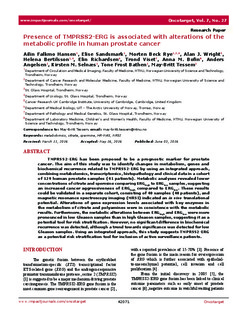| dc.contributor.author | Hansen, Ailin Falkmo | |
| dc.contributor.author | Sandsmark, Elise | |
| dc.contributor.author | Rye, Morten Beck | |
| dc.contributor.author | Wright, Alan J | |
| dc.contributor.author | Bertilsson, Helena | |
| dc.contributor.author | Richardsen, Elin | |
| dc.contributor.author | Viset, Trond | |
| dc.contributor.author | Bofin, Anna M. | |
| dc.contributor.author | Angelsen, Anders | |
| dc.contributor.author | Selnæs, Kirsten Margrete | |
| dc.contributor.author | Bathen, Tone Frost | |
| dc.contributor.author | Tessem, May-Britt | |
| dc.date.accessioned | 2017-01-06T12:27:10Z | |
| dc.date.available | 2017-01-06T12:27:10Z | |
| dc.date.created | 2016-09-12T11:48:47Z | |
| dc.date.issued | 2016 | |
| dc.identifier.citation | OncoTarget. 2016 | nb_NO |
| dc.identifier.issn | 1949-2553 | |
| dc.identifier.uri | http://hdl.handle.net/11250/2426612 | |
| dc.description.abstract | TMPRSS2-ERG has been proposed to be a prognostic marker for prostate cancer. The aim of this study was to identify changes in metabolism, genes and biochemical recurrence related to TMPRSS2-ERG by using an integrated approach, combining metabolomics, transcriptomics, histopathology and clinical data in a cohort of 129 human prostate samples (41 patients). Metabolic analyses revealed lower concentrations of citrate and spermine comparing ERGhigh to ERGlow samples, suggesting an increased cancer aggressiveness of ERGhigh compared to ERGlow. These results could be validated in a separate cohort, consisting of 40 samples (40 patients), and magnetic resonance spectroscopy imaging (MRSI) indicated an in vivo translational potential. Alterations of gene expression levels associated with key enzymes in the metabolism of citrate and polyamines were in consistence with the metabolic results. Furthermore, the metabolic alterations between ERGhigh and ERGlow were more pronounced in low Gleason samples than in high Gleason samples, suggesting it as a potential tool for risk stratification. However, no significant difference in biochemical recurrence was detected, although a trend towards significance was detected for low Gleason samples. Using an integrated approach, this study suggests TMPRSS2-ERG as a potential risk stratification tool for inclusion of active surveillance patients. | nb_NO |
| dc.language.iso | eng | nb_NO |
| dc.publisher | Impact Journals | nb_NO |
| dc.rights | Navngivelse 4.0 Internasjonal | * |
| dc.rights.uri | http://creativecommons.org/licenses/by/4.0/deed.no | * |
| dc.title | Presence of TMPRSS2-ERG is associated with alterations of the metabolic profile in human prostate cancer | nb_NO |
| dc.type | Journal article | nb_NO |
| dc.type | Peer reviewed | nb_NO |
| dc.source.journal | OncoTarget | nb_NO |
| dc.identifier.doi | 10.18632/oncotarget.9817 | |
| dc.identifier.cristin | 1380280 | |
| dc.description.localcode | (C) Author's. All site content, except where otherwise noted, is licensed under a Creative Commons Attribution 3.0 License. | nb_NO |
| cristin.unitcode | 194,65,25,0 | |
| cristin.unitcode | 194,65,15,0 | |
| cristin.unitcode | 194,65,10,0 | |
| cristin.unitname | Institutt for sirkulasjon og bildediagnostikk | |
| cristin.unitname | Institutt for kreftforskning og molekylær medisin | |
| cristin.unitname | Institutt for laboratoriemedisin, barne- og kvinnesykdommer | |
| cristin.ispublished | true | |
| cristin.fulltext | original | |
| cristin.qualitycode | 1 | |

